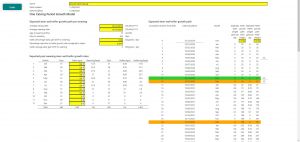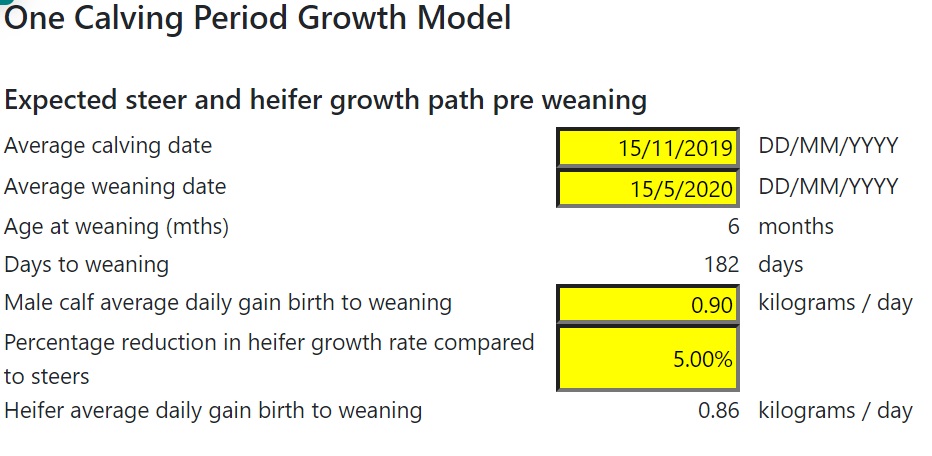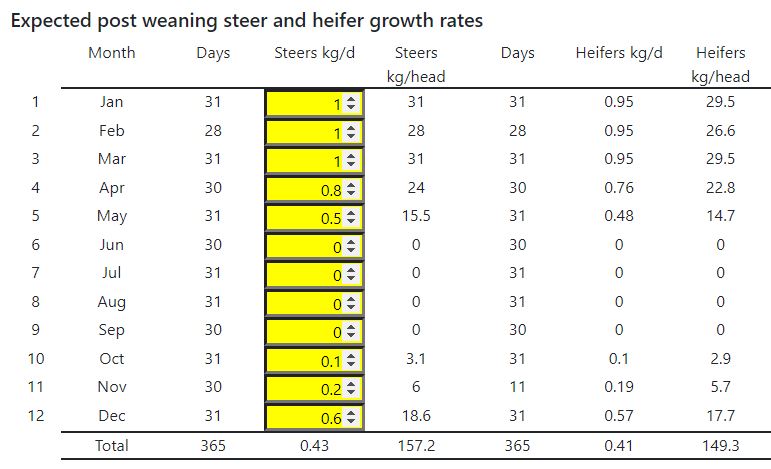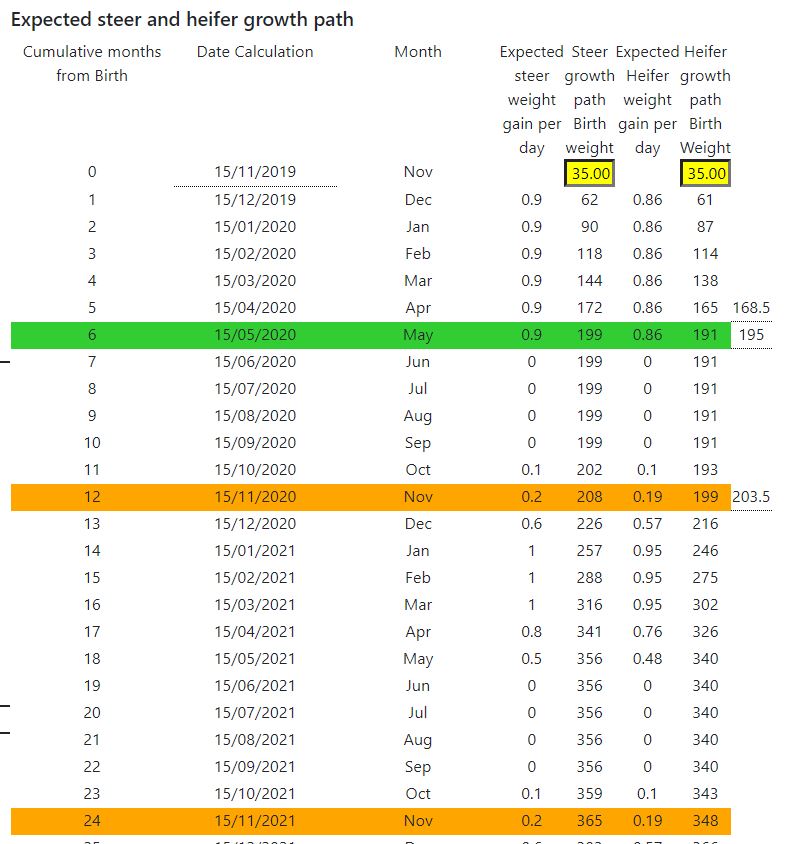Difference between revisions of "Growth Path"
| (41 intermediate revisions by 4 users not shown) | |||
| Line 1: | Line 1: | ||
| − | The Growth Path | + | The Growth Path tool is guide that helps you visualise and estimate the weights of your cattle at certain ages. This will assist you in filling out the [[Breedcow+ AE Calc]] and the [[Dynama+ AECalc]] sheets. It's also very handy in the [[Bullocks]] tool. |
| − | Important! The Growth Path | + | Important! The Growth Path tool does not automatically fill out the AE Calc sheets. |
| + | |||
| + | ==How to use the Growth Path tool== | ||
| + | |||
| + | Upon entering the Growth Path page, the following screen should be displayed. It has some example values - but these won't necessarily match yours.(Hint: Click the picture to make it bigger!). | ||
| + | |||
| + | |||
| + | |||
| + | [[File:GrowthPathWiki.jpg|frameless|Figure 1 - Growth Path Default Screen]] | ||
| + | ===Entering the data=== | ||
| + | |||
| + | Step 1: The "One Calving Period Growth Model" | ||
| + | |||
| + | Firstly, forget the words "One Calving Period Growth Model". Think of the model as the ability to forecast a growth path for an individual animal and then use the forecast to assist in filling out AECalc. Next, think of your weaner mob as an average, individual animal. | ||
| + | |||
| + | For instance, what date would the "average" weaner in your herd be born? If you joined the bulls in January, and approximately 50% of your cattle were pregnant by March, in 9 months' time you will have 50% of your calves! So we might expect average calving date to be sometime in December. In this example, we expect that to be 15/12/2019. Weaning date is typically the date when you wean - if you do several rounds of weaning - think about the "average" weaner. | ||
| + | |||
| + | The next yellow box "Male calf average daily gain birth to weaning" is used mostly so that our weaning weight is about right for our herd. We can check that a little later on. | ||
| + | |||
| + | The last yellow box in section 1 is "Percentage reduction in heifer growth rate compared to steers" - typically we use about 5%, however, if you have great data on this, feel free to change it. | ||
| + | |||
| + | [[File:GrowthPathSection1.jpg|centre|frame|Figure 2 - One Calving Period Growth Model]] | ||
| + | |||
| + | Step 2: Average daily liveweight gains by month. | ||
| + | |||
| + | Using the arrows, or entering directly into the cell, add in your average liveweight gains you expect in the various months. For instance, in the following image (Figure 3), we expect the cattle to put on 1kg per day during January, February and March. So we add 1 to each of those months. For each month, add in your expected, or average, liveweight gains. | ||
| + | |||
| + | [[File:LWG.JPG|centre|frame|Figure 3 - Average Daily Liveweight Gain by month]] | ||
| + | |||
| + | ===Reading the results=== | ||
| + | |||
| + | Depending on your screen size, or how you are accessing the wiki, A table will appear to the right of, or below, the liveweight gain by month input table. This will help with two things. | ||
| + | 1. It will allow you to see whether your liveweight gain entries are correct | ||
| + | 2. It will suggest data that can be added to AECalc. | ||
| + | |||
| + | An example in the following image (Figure 4) demonstrates how to interpret the results. | ||
| + | For instance, the green line, is the "weaning weight line" and provides a weaning weight of 199kg for steers and 191 kg for heifers, with an average of 195kg. This weight can then be used in AECalc, if selling weaners. If this weight doesn't align with your historical experiences on your property, you will need to change the calf average daily gain until it does. As a note, it is possible to change the birth weight at the top of the table. A default value has been provided based on our experiences, but this can be changed, depending on your region and breed. | ||
| + | Another data point to check is the saleweights. For example, if you are turning off 365kg 2 (24 months) year old steers, reading the 24 month old row (in this case highlighted in orange) shows our steers are at 365kg. This means we have confidence our growth path is correct. If for example, that was reading 400kg, not 365, we know our growth path daily gains are too high and must be re-adjusted (see Step 2 above). | ||
| + | Importantly, the growth path provides a "5 month old" weight, this weight is important in the AECalc spreadsheets. In this case it is 168.5kg | ||
| + | |||
| + | |||
| + | [[File:Growthpathsection3.JPG|centre|frame|Figure 4 - Expected steer and heifer growth path]] | ||
Latest revision as of 04:50, 6 May 2025
The Growth Path tool is guide that helps you visualise and estimate the weights of your cattle at certain ages. This will assist you in filling out the Breedcow+ AE Calc and the Dynama+ AECalc sheets. It's also very handy in the Bullocks tool.
Important! The Growth Path tool does not automatically fill out the AE Calc sheets.
How to use the Growth Path tool
Upon entering the Growth Path page, the following screen should be displayed. It has some example values - but these won't necessarily match yours.(Hint: Click the picture to make it bigger!).
Entering the data
Step 1: The "One Calving Period Growth Model"
Firstly, forget the words "One Calving Period Growth Model". Think of the model as the ability to forecast a growth path for an individual animal and then use the forecast to assist in filling out AECalc. Next, think of your weaner mob as an average, individual animal.
For instance, what date would the "average" weaner in your herd be born? If you joined the bulls in January, and approximately 50% of your cattle were pregnant by March, in 9 months' time you will have 50% of your calves! So we might expect average calving date to be sometime in December. In this example, we expect that to be 15/12/2019. Weaning date is typically the date when you wean - if you do several rounds of weaning - think about the "average" weaner.
The next yellow box "Male calf average daily gain birth to weaning" is used mostly so that our weaning weight is about right for our herd. We can check that a little later on.
The last yellow box in section 1 is "Percentage reduction in heifer growth rate compared to steers" - typically we use about 5%, however, if you have great data on this, feel free to change it.
Step 2: Average daily liveweight gains by month.
Using the arrows, or entering directly into the cell, add in your average liveweight gains you expect in the various months. For instance, in the following image (Figure 3), we expect the cattle to put on 1kg per day during January, February and March. So we add 1 to each of those months. For each month, add in your expected, or average, liveweight gains.
Reading the results
Depending on your screen size, or how you are accessing the wiki, A table will appear to the right of, or below, the liveweight gain by month input table. This will help with two things. 1. It will allow you to see whether your liveweight gain entries are correct 2. It will suggest data that can be added to AECalc.
An example in the following image (Figure 4) demonstrates how to interpret the results. For instance, the green line, is the "weaning weight line" and provides a weaning weight of 199kg for steers and 191 kg for heifers, with an average of 195kg. This weight can then be used in AECalc, if selling weaners. If this weight doesn't align with your historical experiences on your property, you will need to change the calf average daily gain until it does. As a note, it is possible to change the birth weight at the top of the table. A default value has been provided based on our experiences, but this can be changed, depending on your region and breed. Another data point to check is the saleweights. For example, if you are turning off 365kg 2 (24 months) year old steers, reading the 24 month old row (in this case highlighted in orange) shows our steers are at 365kg. This means we have confidence our growth path is correct. If for example, that was reading 400kg, not 365, we know our growth path daily gains are too high and must be re-adjusted (see Step 2 above). Importantly, the growth path provides a "5 month old" weight, this weight is important in the AECalc spreadsheets. In this case it is 168.5kg



